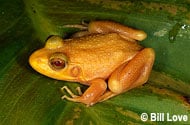Description:
If the proper environment is provided, the American bullfrog will thrive under captive conditions. The ideal situation is a large pond designed so that the animal cannot escape and invade surrounding habitat. This is one species that has been successfully maintained in large outdoor ponds. If keeping this species indoors, a 55-gallon aquarium should be the considered the minimum size enclosure to accommodate this large species. Perhaps even better is the use of a large stock tank or tub available from hydroponics outlets. The cage should contain a large aquatic area, and the frogs should be able to fully submerge themselves in water. Also integral to cage design is the use of both a UVA basking bulb and a UVB light source. In the wild, these animals spend some time basking and the use of these lights will be helpful in keeping these animals healthy in the long term. Aquatic and terrestrial vegetation is helpful in providing these secretive animals with a place to remain hidden from view. Ambient temperatures of 75 to 80 degrees Fahrenheit are considered ideal for the maintenance of this species. Slightly higher temperatures under the basking site allow these animals to warm up if necessary. A cage top should be in place to prevent this animal, which can jump great distances, from leaving the enclosure. Crickets make a good staple food item. Supplement these with mealworms, silk worm larvae, earthworms and small rodents. American bullfrogs have a voracious appetite and can become obese if overfed. As such, small rodents should be fed sparingly in order to prevent obesity, and secondary metabolic issues. Gut loading crickets with a large variety of vegetables and commercial cricket food is a good way to provide nutritious food items. A vitamin/mineral supplement is also a good idea with this species, especially for younger animals still undergoing periods of rapid growth. This will help to ensure proper bone development.
Habitat:
Usually found in or near a permanent water source, including streams, ponds and rivers. Occasionally will travel miles from a permanent water source during the rainy season and “hole up” in small ponds during dry spells.
Range:
The American bullfrog is native to the United States, Canada and Mexico, east of the Rocky Mountains. They have been introduced in much of the Western United States.
Scientific Name: Lithobates catesbeianus
Species Group: frog
Family: Ranidae
Size: Up to 8 inches
Level: intermediate
Weight: N/A
Dangerous: No



